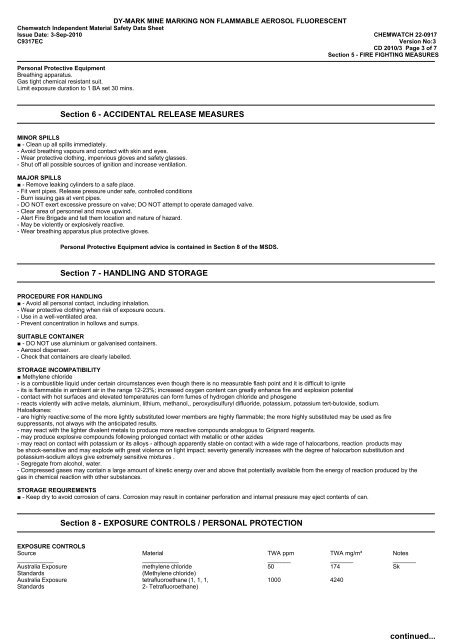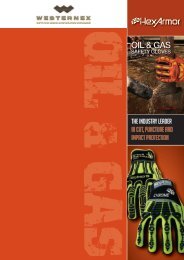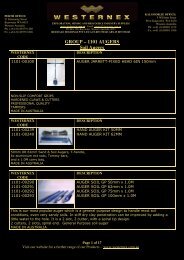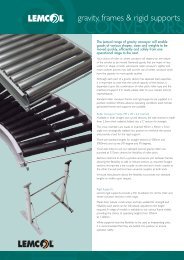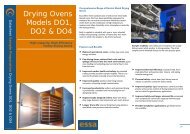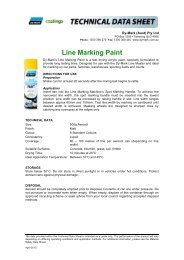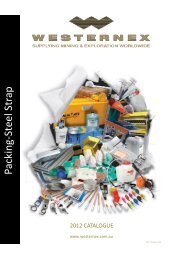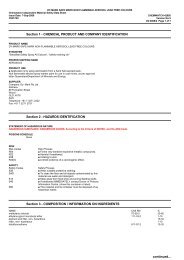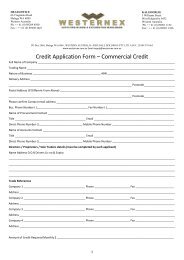Chemwatch Australian MSDS 22-0917 - Westernex
Chemwatch Australian MSDS 22-0917 - Westernex
Chemwatch Australian MSDS 22-0917 - Westernex
Create successful ePaper yourself
Turn your PDF publications into a flip-book with our unique Google optimized e-Paper software.
continued...<br />
DY-MARK MINE MARKING NON FLAMMABLE AEROSOL FLUORESCENT<br />
<strong>Chemwatch</strong> Independent Material Safety Data Sheet<br />
Issue Date: 3-Sep-2010 CHEMWATCH <strong>22</strong>-<strong>0917</strong><br />
C9317EC<br />
Version No:3<br />
CD 2010/3 Page 3 of 7<br />
Section 5 - FIRE FIGHTING MEASURES<br />
Personal Protective Equipment<br />
Breathing apparatus.<br />
Gas tight chemical resistant suit.<br />
Limit exposure duration to 1 BA set 30 mins.<br />
Section 6 - ACCIDENTAL RELEASE MEASURES<br />
MINOR SPILLS<br />
■ - Clean up all spills immediately.<br />
- Avoid breathing vapours and contact with skin and eyes.<br />
- Wear protective clothing, impervious gloves and safety glasses.<br />
- Shut off all possible sources of ignition and increase ventilation.<br />
MAJOR SPILLS<br />
■ - Remove leaking cylinders to a safe place.<br />
- Fit vent pipes. Release pressure under safe, controlled conditions<br />
- Burn issuing gas at vent pipes.<br />
- DO NOT exert excessive pressure on valve; DO NOT attempt to operate damaged valve.<br />
- Clear area of personnel and move upwind.<br />
- Alert Fire Brigade and tell them location and nature of hazard.<br />
- May be violently or explosively reactive.<br />
- Wear breathing apparatus plus protective gloves.<br />
Personal Protective Equipment advice is contained in Section 8 of the <strong>MSDS</strong>.<br />
Section 7 - HANDLING AND STORAGE<br />
PROCEDURE FOR HANDLING<br />
■ - Avoid all personal contact, including inhalation.<br />
- Wear protective clothing when risk of exposure occurs.<br />
- Use in a well-ventilated area.<br />
- Prevent concentration in hollows and sumps.<br />
SUITABLE CONTAINER<br />
■ - DO NOT use aluminium or galvanised containers.<br />
- Aerosol dispenser.<br />
- Check that containers are clearly labelled.<br />
STORAGE INCOMPATIBILITY<br />
■ Methylene chloride<br />
- is a combustible liquid under certain circumstances even though there is no measurable flash point and it is difficult to ignite<br />
- its is flammable in ambient air in the range 12-23%; increased oxygen content can greatly enhance fire and explosion potential<br />
- contact with hot surfaces and elevated temperatures can form fumes of hydrogen chloride and phosgene<br />
- reacts violently with active metals, aluminium, lithium, methanol,, peroxydisulfuryl difluoride, potassium, potassium tert-butoxide, sodium.<br />
Haloalkanes:<br />
- are highly reactive:some of the more lightly substituted lower members are highly flammable; the more highly substituted may be used as fire<br />
suppressants, not always with the anticipated results.<br />
- may react with the lighter divalent metals to produce more reactive compounds analogous to Grignard reagents.<br />
- may produce explosive compounds following prolonged contact with metallic or other azides<br />
- may react on contact with potassium or its alloys - although apparently stable on contact with a wide rage of halocarbons, reaction products may<br />
be shock-sensitive and may explode with great violence on light impact; severity generally increases with the degree of halocarbon substitution and<br />
potassium-sodium alloys give extremely sensitive mixtures .<br />
- Segregate from alcohol, water.<br />
- Compressed gases may contain a large amount of kinetic energy over and above that potentially available from the energy of reaction produced by the<br />
gas in chemical reaction with other substances.<br />
STORAGE REQUIREMENTS<br />
■ - Keep dry to avoid corrosion of cans. Corrosion may result in container perforation and internal pressure may eject contents of can.<br />
Section 8 - EXPOSURE CONTROLS / PERSONAL PROTECTION<br />
EXPOSURE CONTROLS<br />
Source Material TWA ppm TWA mg/m³ Notes<br />
___________ ___________ _______ _______ _______<br />
Australia Exposure methylene chloride 50 174 Sk<br />
Standards<br />
(Methylene chloride)<br />
Australia Exposure tetrafluoroethane (1, 1, 1, 1000 4240<br />
Standards<br />
2- Tetrafluoroethane)


